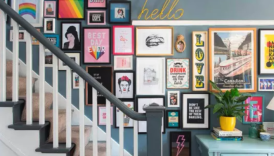From Plain to Posh: Revamp Your Walls with Plaster Artistry

Importance of Wall Decor
Wall decor plays a vital role in transforming a house into a home. It serves not only to beautify spaces but also to express personal style and create a welcoming atmosphere. Whether it’s a stunning piece of artwork, a vibrant mural, or intricate plaster designs, these elements can significantly influence the ambiance of any room. Consider how a meticulously crafted wall can inspire feelings of warmth or sophistication. It’s often said that “walls have stories,” and decor pieces echo experiences, memories, and aspirations. Some benefits of investing in wall decor include:
- From Plain to Posh: Revamp Your Walls with Plaster Artistry
- Importance of Wall Decor
- Evolution of Plaster Artistry
- Types of Plaster Materials
- Lime Plaster
- Clay Plaster
- Techniques of Plaster Artistry
- Venetian Plaster
- Stucco
- Choosing the Right Design
- Traditional vs. Modern Patterns
- Customization Options
- Preparing Your Walls
- Surface Preparation
- Priming Techniques
- Application Process
- Step-by-Step Guide
- Common Mistakes to Avoid
- Adding Texture and Dimension
- Incorporating Raised Patterns
- Creating Faux Finishes
- Maintenance and Care Tips
- Cleaning Methods
- Repairing Damages
- Showcase: Inspirational Plaster Artistry Projects
- Residential Spaces
- Commercial Interiors
- Enhanced Aesthetics: Beautiful designs elevate the visual appeal.
- Personal Expression: Showcase your unique personality and values.
- Cohesion and Harmony: Well-placed decor ties together different elements of a room.
Evolution of Plaster Artistry
Historically, plaster artistry has evolved from basic techniques to elaborate forms that reflect cultural and artistic shifts over centuries. In ancient civilizations like Egypt and Rome, artisans utilized plaster to create intricate moldings and sculptures that still astound us today. Over time, techniques have been refined:
- Renaissance Era: Featured detailed frescoes and sophisticated textures.
- Modern Day: Emphasizes versatility, with styles ranging from minimalist to flamboyant.
This evolution not only showcases the skill and creativity involved but also highlights how plaster art continues to enrich interiors with depth and character.
Types of Plaster Materials
Lime Plaster
One of the oldest forms of plaster, lime plaster has been used for millennia due to its natural properties and durability. When you touch a well-applied lime plaster wall, you can feel a cool, breathable surface that creates a comfortable indoor environment. Its benefits are numerous:
- Breathability: Allows moisture to escape, preventing mold growth.
- Flexibility: Adapts to the movement of a building, reducing cracking.
- Eco-Friendly: Made from abundant natural materials, it’s a sustainable option.
Many homeowners today appreciate lime plaster for its rustic texture and visual warmth, which adds a touch of history to modern designs.
Clay Plaster
Another natural choice, clay plaster offers a unique aesthetic and several compelling advantages. It’s often favored for its earthy tones and tactile finish, which can create a serene and calming atmosphere in any space. Here are some reasons why clay plaster is gaining popularity:
- Non-Toxic: Free from harmful chemicals, making it safe for indoor air quality.
- Thermal Regulation: Helps to maintain consistent indoor temperatures.
- Customization: Available in various finishes, allowing for personalized design.
Using clay plaster can evoke a sense of connection to nature, perfect for those looking to bring the outdoors inside. Whether it’s for a rustic cottage or a contemporary urban home, these plaster materials offer endless possibilities in interior design.
Techniques of Plaster Artistry
Venetian Plaster
One of the most celebrated techniques in plaster artistry, Venetian plaster, creates a stunning marble-like finish that exudes elegance. It originated in the palaces of Venice and is often associated with luxurious interiors. The process is labor-intensive, requiring skill and precision, but the results are mesmerizing. What makes Venetian plaster truly special includes:
- Layering Technique: Multiple thin layers are applied, each polished to perfection.
- Versatile Effects: It can mimic stone, wood, or even metallic finishes.
- Durability: It’s long-lasting, resistant to wear and tear.
Homeowners often choose Venetian plaster for accent walls or as part of decorative ceilings, giving spaces a sophisticated and timeless feel.
Stucco
Stucco, in contrast, offers a more textured and rustic aesthetic. It’s been used for centuries in both interior and exterior designs, lending buildings character and charm. This technique is favored for its:
- Textured Finish: Available in a variety of styles, from smooth to heavily textured.
- Weather Resistance: Particularly useful for outdoor applications due to its durability.
- Cost-Effectiveness: A more budget-friendly option compared to other decorative plaster techniques.
Stucco can be playful or formal, allowing homeowners to express their style while enhancing the architectural features of their homes. Whether you’re enhancing a cozy living space with Venetian plaster or adding a touch of old-world charm with stucco, these techniques highlight the artistry of plasterwork while elevating overall design aesthetics.
Choosing the Right Design
Traditional vs. Modern Patterns
When it comes to selecting the right design for plaster artistry, the choice between traditional and modern patterns can significantly influence the overall atmosphere of your space. Traditional patterns often evoke a sense of nostalgia, featuring intricate motifs and rich textures that tell a story. These designs can include:
- Baroque Elements: Ornate, flowing shapes often used in historical buildings.
- Geometric Patterns: Timeless shapes that add sophistication to walls.
On the other hand, modern patterns emphasize minimalism and clean lines, reflecting a contemporary lifestyle. Considerations include:
- Abstract Designs: Unique forms and asymmetrical patterns that invite curiosity.
- Monochromatic Schemes: A focus on subtle hues that contribute to tranquil environments.
Both styles have their merits and can dramatically impact the feel of a home, making the choice a deeply personal one.
Customization Options
Beyond choosing between traditional and modern, homeowners have an extensive range of customization options. Personalizing your plaster work allows you to reflect your style and values. Here are some ideas for customization:
- Color Selection: Opt for shades that complement your existing decor.
- Textural Variety: Mix different textures to create depth and interest.
- Unique Patterns: Collaborate with artisans to develop one-of-a-kind designs.
When investing in wall decor, embracing the customization aspect not only enhances aesthetics but also cultivates a space that truly feels like home. Each design choice is an opportunity to express individuality and create a lasting impression.
Preparing Your Walls
Surface Preparation
Before embarking on your plaster artistry journey, ensuring that your walls are properly prepared is crucial. This step significantly influences the outcome of your project. A well-prepared surface not only enhances adhesion but also ensures a smooth, clean finish. Here’s how to get started:
- Clean the Surface: Remove dirt, dust, and grease. A simple mixture of soap and water can work wonders.
- Repair Imperfections: Fill in cracks and holes with a patching compound to create an even surface.
- Sanding: Lightly sand the walls to promote better adhesion for the plaster. This is particularly important for previously painted or glossy surfaces.
With a good foundation in place, you pave the way for a flawless application of plaster techniques.
Priming Techniques
After preparing the surface, applying a primer is essential to achieve optimal results. A primer creates a bonding layer for the plaster, reducing absorbency and ensuring a uniform application. Consider these techniques:
- Choose the Right Primer: Look for a product specifically designed for plaster applications.
- Even Application: Use a roller or spray gun to apply the primer evenly, avoiding drips and pooling.
- Drying Time: Allow the primer to dry completely before moving on to the plastering process. A few hours is typically sufficient.
Taking the time to properly prepare and prime your walls sets the stage for a stunning plaster finish that you’ll be proud to showcase in your home. Simple yet effective, these steps help ensure that your artistic vision comes to life beautifully.
Application Process
Step-by-Step Guide
Once your walls are adequately prepared and primed, the excitement of applying plaster can begin! Following a structured approach ensures that the process goes smoothly and produces professional results. Here’s a simple step-by-step guide to get you started:
- Gather Materials: You’ll need plaster, a trowel, a hawk, a sponge, and a misting bottle.
- Mix the Plaster: Combine according to the manufacturer’s instructions until you achieve a smooth, workable consistency.
- Apply the First Coat: Using the trowel, spread the plaster evenly onto the wall, starting from one corner and working your way across. Aim for a thickness of about 1/8 inch.
- Smooth the Surface: Once applied, use the trowel’s edge to smooth the surface. A wet sponge can help achieve a finer finish.
- Allow to Dry: Let the first coat dry properly before applying additional layers, if necessary.
Common Mistakes to Avoid
While plastering can be a rewarding process, there are a few common pitfalls to watch out for:
- Skipping Surface Preparation: Failing to thoroughly clean and repair walls can result in poor adhesion.
- Overworking the Plaster: Trying to re-smooth plaster once it starts to set can create a rough surface.
- Applying Too Thick a Layer: Thick layers may crack as they dry; it’s better to apply multiple thin layers.
By following these steps and keeping an eye out for common mistakes, you can achieve a flawless plaster finish that enhances your home’s aesthetics and durability. With patience and practice, your walls will become a canvas of creativity!
Adding Texture and Dimension
Incorporating Raised Patterns
Adding texture and dimension to plaster walls can elevate your interior design, making spaces feel more inviting and visually interesting. One popular method is incorporating raised patterns, which can range from subtle designs to bold statements. Here are some ways to get started:
- Stencils: Use stencils to create intricate patterns. Place the stencil against the wall and apply a thin layer of plaster over it, then remove it to reveal the design.
- Textured Tools: Specialty tools, such as combs or brushes, can create unique textures. Experiment with different patterns by varying the pressure and angle while applying plaster.
- Layering Techniques: By applying multiple layers of plaster and carving into the top layer, you can achieve stunning relief effects that catch the light beautifully.
Creating Faux Finishes
Faux finishes are another excellent way to mimic expensive materials without the high price tag. Techniques like these can transform ordinary plaster in fascinating ways:
- Marble Effect: Combine different shades of colored plaster, blending them while still wet to create a realistic marbled look.
- Metallic Finishes: Use metallic pigments mixed into the plaster for a shimmering effect that adds luxury to any room.
- Wood Grain Patterns: With the right tools and techniques, you can create stunning wood-like textures, perfect for adding warmth to a space.
Incorporating raised patterns and faux finishes allows homeowners to personalize their aesthetics, turning plain walls into captivating features that reflect their unique style. With creativity and a bit of practice, your walls can truly become a work of art.
Maintenance and Care Tips
Cleaning Methods
Once you’ve invested time and creativity into your plaster artistry, maintaining its beauty is essential. Regular cleaning not only keeps walls looking fresh but also prolongs their life. Here are some effective cleaning methods to consider:
- Dusting: Use a soft cloth, feather duster, or a microfiber cloth to gently remove dust and cobwebs from the surface.
- Gentle Cleaning Solution: For deeper cleaning, mix a small amount of mild soap with warm water. Dip a soft sponge into the solution and wring it out thoroughly before gently wiping the walls.
- Avoid Harsh Chemicals: Steer clear of abrasive cleaners or scrub brushes, as they can damage the plaster surface.
A personal tip? I’ve always found that a damp sponge works wonders for quick touch-ups, making it easy to keep walls looking pristine without much hassle.
Repairing Damages
Even with diligent care, accidents can happen—scratches, chips, or cracks may appear. Fortunately, repairing your plaster walls is manageable with the right approach.
- Minor Scratches: For light scratches, simply dab a bit of matching paint or plaster into the area with a fine brush to blend it in.
- Cracks or Chips: Use a patching compound to fill in deeper damage. Smooth it out with a putty knife, allowing it to dry fully before sanding down for a seamless finish.
- Repainting: If a section looks particularly worn, repainting the area can revitalize the overall appearance.
By following these maintenance and repair tips, your plaster artistry can continue to shine for years to come, providing a stunning backdrop to your home. Embracing these simple care practices ensures that your creative investment is both beautiful and lasting.
Showcase: Inspirational Plaster Artistry Projects
Residential Spaces
Plaster artistry can transform a residential space into something truly unique and inviting. Many homeowners enjoy experimenting with various textures and designs, creating stunning focal points within their homes.
- Accent Walls: A living room featuring a Venetian plaster accent wall can serve as a conversation starter and a beautiful backdrop for family gatherings.
- Ceilings: Applying a textured plaster to ceilings adds depth and character. Imagine walking into a dining room where the ceiling imitates a serene sky, enhancing mealtime ambiance.
One of my friends recently renovated their bedroom with a soft clay plaster finish that not only looks gorgeous but also contributes to a soothing atmosphere.
Commercial Interiors
In commercial settings, plaster artistry offers an opportunity to convey brand identity and style. Businesses can utilize plaster to create memorable experiences for clients and customers alike.
- Reception Areas: A sleek, modern stucco finish in a reception area can impress visitors and establish a welcoming atmosphere.
- Restaurants: Many eateries are now opting for textured plaster walls to evoke warmth, often using faux finishes to create rustic, charming interiors.
These projects illustrate how plaster can enhance both residential and commercial spaces alike, ensuring every environment feels curated, comfortable, and visually attractive. Whether in a cozy home or a bustling business, plaster artistry holds the potential to elevate design and inspire creativity.





